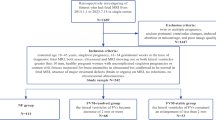Abstract
Objectives
The purpose of this study was to investigate the use of MRI in predicting prostate growth and development.
Methods
A total of 1,500 healthy male volunteers who underwent MRI of the pelvis were included in this prospective study. Subjects were divided into five groups according to age (group A, 2–5 years; group B, 6–10 years; group C, 11-15 years; group D, 16-20 years; group E, 21-25 years). Total prostate volume (TPV) as well as prostate central zone (CZ) and peripheral zone (PZ) were measured and evaluated on MRI. Data of the different groups were compared using variance analysis, Scheffé's method, Kruskal–Wallis H-test, and Pearson’s correlation. Statistical significance was inferred at P < 0.05.
Results
In groups A and B, the prostates were barely visible. In group C, although TPV was measured, it was hard to distinguish CZ and PZ. In group D, 136 CZ and PZ were clearly visible. In group E, 377 CZ and PZ were clearly visible on T2-weighted imaging (T2WI). The median TPVs of groups A, B, C, D, and E were 0.00 cm3, 0.05 cm3, 2.83 cm3, 8.32 cm3, and 11.56 cm3, respectively, and the median prostate development scores were 0.08, 0.69, 1.56, 2.38, and 2.74, respectively. Both TPVs and zonal anatomy scores varied significantly among the five groups (P = 0.000). TPV and zonal anatomy score increased with increasing age.
Conclusions
MRI provides a reliable quantitative reference for prostate growth and development.
Key Points
• When and how the prostate develops after birth remains unclear.
• Prostate volume increases rapidly after the age of 10 years.
• MRI provides a reliable objective and quantitative reference for prostate growth and development.




Similar content being viewed by others
References
Freddie B, Ahmedin J, Nathan G et al (2012) Global cancer transitions according to the Human Development Index (2008–2030): a population-based study. Lancet Oncol 13(8):790–801
Siegel R, Naishadham D, Jemal A (2013) Cancer statistics, 2013. CA Cancer J Clin 63:11–30
Ren J, Yang Y, Zhang JS et al (2013) T2-weighted combined with diffusion-weighted images for evaluating prostatic transition zone tumors at 3 tesla. Future Oncol 9(4):585–93
Gossner J (2012) Computed tomography of the prostate – a review. Int J Radiol 14(1):1
Williams AM, Simon I, Landis PK et al (1999) Prostatic growth rate determined from MRI data: age-related longitudinal changes. J Androl 20(4):474–80
Tamada T, Sone T, Toshimitsu S et al (2008) Age-related and zonal anatomical changes of apparent diffusion coefficient values in normal human prostatic tissues. J Magn Reson Imaging 27:552–6
Timms BG, Hofkamp LE (2011) Prostate development and growth in benign prostatic hyperplasia. Differentiation 82(45):173–83
Oesterling JE, Jacobsen SJ, Chute CG et al (1993) Serum prostate-specific antigen in a community-based population of healthy men: establishment of age-specific reference ranges. JAMA 270:860–4
Rhodes T, Girman CJ, Jacobsen SJ et al (1999) Longitudinal prostate growth rates during 5 years in randomly selected community men 40–79 years old. J Urol 161:1174–9
Jeong CW, Park HK, Hong SK et al (2008) Comparison of prostate volume measured by transrectal ultrasonography and MRI with the actual prostate volume measured after radical prostatectomy. Urol Int 81:179–85
Lee JS, Chung BH (2007) Transrectal ultrasound versus magnetic resonance imaging in the estimation of prostate volume as compared with radical prostatectomy specimens. Urol Int 78:323–7
Aarnink RG, de la Rosette JJ, Debruyne FM et al (1996) Formula-derived prostate volume determination. Eur Urol 29:399–402
Bangma CH, Niemer AQ, Grobbee DE et al (1996) Transrectal ultrasonic volumetry of the prostate: in vivo comparison of different methods. Prostate 28:107–10
Eri LM, Thomassen H, Brennhovd B et al (2002) Accuracy and repeatability of prostate volume measurements by transrectal ultrasound. Prostate Cancer Prostatic Dis 5:273–8
Villeirs GM, Verstraete KL, De Neve WJ et al (2005) Magnetic resonance imaging anatomy of the prostate and periprostatic area: a guide for radiotherapists. Radiother Oncol 76:99–106
Shapiro E, Hartanto V, Perlman EJ et al (1997) Morphometric analysis of pediatric and nonhyperplastic prostate glands: evidence that BPH is not a unique stromal process. Prostate 33:177–82
Zondek T, Zondek LH (1975) The fetal and neonatal prostate. In: Goland M (ed) Normal and Abnormal Growth of the Prostate. Thomas, Springfield, pp 5–28
Aumuller G (1991) Postnatal development of the prostate. Bull Assoc Anat (Nancy) 75:39–42
Ingram S, Hollman AS, Azmy AF (1994) Ultrasound evaluation of the paediatric prostate. Br J Urol 74(5):601–3
Williams AM, Simon I, Landis PK et al (1999) Prostatic growth rate determined from MRI data: age-related longitudinal changes. J Androl 20:474–80
Allen KS, Kressel HY, Arger PH et al (1989) Age-related changes of the prostate: evaluation by MR imaging. AJR 152:77–81
Turkbey B, Huang R, Vourganti S et al (2012) Age related changes in prostate zonal volume as measured by high resolution prostate MRI: a cross sectional study in over 500 patients. BJU Int 110(11):1642–7
Zaichick V, Zaichick S (2014) Age-related histological and zinc content changes in adult nonhyperplastic prostate glands. Age (Dordr) 36(1):167–81
Zhang SJ, Qian HN, Zhao Y et al (2013) Relationship between age and prostate size. Asian J Androl 15:116–20
Acknowledgments
The scientific guarantor of this publication is Professor Yi Huan. The authors of this manuscript declare no relationships with any companies whose products or services may be related to the subject matter of the article. This study received funding from the National Natural Science of China Foundation and high-tech clinical projects of Xijing Hospital (Grants NSFC 81370039, NSFC 81220108011, and XJGX13LC11). No complex statistical methods were necessary for this paper. Institutional Review Board approval was obtained. Written informed consent was obtained from all subjects (patients) in this study. The study subjects or cohorts have not been previously reported. Methodology: retrospective diagnostic or prognostic study, performed at one institution.
Author information
Authors and Affiliations
Corresponding author
Rights and permissions
About this article
Cite this article
Ren, J., Liu, H., Wang, H. et al. MRI to predict prostate growth and development in children, adolescents and young adults. Eur Radiol 25, 516–522 (2015). https://doi.org/10.1007/s00330-014-3372-x
Received:
Revised:
Accepted:
Published:
Issue Date:
DOI: https://doi.org/10.1007/s00330-014-3372-x




